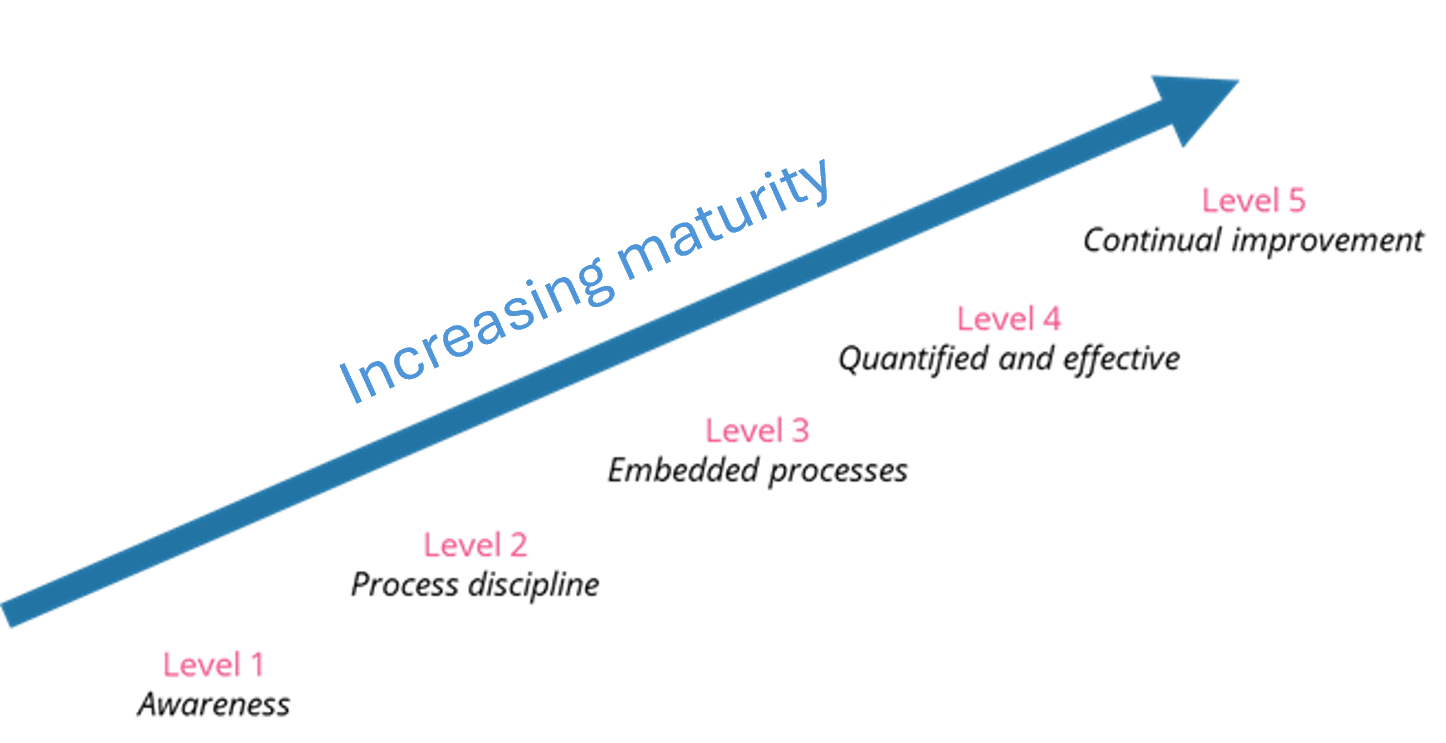A quick internet search will tell you that there are hundreds if not thousands of maturity models out there. The vast majority you can discount because they have no provenance or may have been developed by an individual, perhaps with a specific purpose in mind. Those maturity models with provenance generally fall into two camps: those with 4 levels of maturity and those with 5; the trend is toward 5 levels.
Why levels? An organisation cannot be mature or not – it’s not that black and white. Capability improvement is a journey and therefore has steps along the way. Maturity models use levels to describe capability at these steps.
Characteristics in a portfolio, programme and project management (P3M) environment
Sometimes the language used in maturity models can be a little daunting and make it hard to understand the changes that occur as capabilities improve. I have therefore summarised some of the key things that might be happening in an organisation at each level of maturity.
The lists are by no means exhaustive, and I have only focused on a handful of important areas, but you should be able to identify progression as maturity increases.
Level 1
- There are few, if any, documented P3M processes, terminology, guidance or supporting documentation such as templates, although there may be awareness that they are needed. Instead, P3M practice is subjective, driven by individuals, and variable in its nature.
- There are examples of roles and responsibilities being defined for change initiatives.
- There are examples of organisation leaders being aware of the need for adherence to P3M practices and processes.
- Some form of P3M-related assurance may be taking place.
- There will likely be widespread budget and cost underruns and overruns, with performance targets being set based on limited, if any, data.
- If any P3M-related personal development is taking place, it is likely limited to generic training.
- Where there is evidence of successful portfolios, programmes or projects, that success is often based on the knowledge and experience of key individuals – “heroes”.
Level 2
- Repeatable P3M processes have been developed but they are neither fully integrated nor consistently adopted by the whole organisation, and their adoption is unlikely to be widespread or rigorous.
- Portfolios, programmes and projects are managed in accordance with documented plans and some management information is available to decision-makers.
- P3M roles and responsibilities are becoming better defined but they are not consistently deployed across the whole organisation.
- Organisation leaders encourage others to follow P3M processes.
- P3M-related assurance reviews are taking place, with assurance information being available to organisation leaders.
- Widespread budget and cost underruns and overruns remain, but performance targets are set based on emerging data sets.
- Generic P3M training is more widely available but P3M-related personal development activities are not centrally coordinated
Level 3
- Standardised and fully documented P3M processes are in place, can be flexed as required, and are integrated with some other business processes.
- P3M processes are owned by a central body which has a mandate to maintain and improve them (this body is sometimes called a “Centre of Excellence”).
- P3M roles and responsibilities are standardised and consistently deployed across the whole organisation.
- Organisation leaders are actively engaged with P3M processes.
- Integrated assurance is being carried out based on a centrally defined approach.
- Realistic budget and cost targets are being set, with more initiatives delivering “on target” and with underruns and overruns being less common or severe.
- P3M-related personal development activities are centrally controlled, include a range of approaches and take account of individual learning styles.
Level 4
- The performance of P3M processes is analysed by a central body to identify issues and trends which are then used to improve the performance of the processes and to plan interventions where necessary.
- P3M-related management information is analysed for effectiveness, with information collection and reporting approaches being refined.
- Organisation leaders are fully committed to P3M processes.
- The results of P3M-related assurance activities are analysed for opportunities to improve.
- Budget and cost targets are set by analysing past performance, with underruns and overruns becoming rare.
- The effectiveness of P3M-related personal development is analysed and improved.
Level 5
- Performance modelling or similar methods are used to ensure P3M processes are continually improved, considering future business needs and the external environment.
- Organisation leaders have the necessary P3M-related skills and are held accountable for P3M performance.
- The organisation continually monitors the results from P3M-related assurance activities and proactively improves its approach.
- Accurate, knowledge-based budget and cost targets are set, with underruns and overruns being almost non-existent.
- The organisation anticipates future capacity demand and reflects this within its P3M-related personal development plans.
Take-aways

- Level 1 organisations are aware that portfolios, programmes and projects need to be managed differently from “business as usual” activities and may be taking steps to develop P3M-related practices and processes.
- Level 2 organisations portfolios, programmes and projects are managed with their own processes and procedures, but not to a centrally defined standard approach.
- Level 3 organisations manage portfolios, programmes and projects using a centrally defined standard approach which can be tailored to the needs of an individual change initiative.
- Level 4 organisations analyse the performance of their portfolios, programmes and projects to better predict future performance and to improve their P3M-related processes.
- Level 5 organisations have continual improvement initiatives which seek to optimise the performance of their P3M-related processes.





